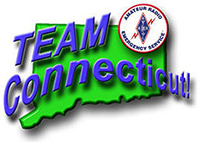CT ARES 2023 SET – Thank you to all who particpated!
Connecticut ARES
The Amateur Radio Emergency Service (ARES) consists of licensed amateurs who have voluntarily registered their qualifications and equipment, with their local ARES leadership, for communications duty in the public service when disaster strikes.
ARES Membership Requirements
Every licensed amateur, regardless of membership in ARRL or any other local or national organization is eligible to apply for membership in ARES. Training may be required or desired to participate fully in ARES. Please inquire at the local level for specific information. Because ARES is an Amateur Radio program, only licensed radio amateurs are eligible for membership. The possession of emergency-powered equipment is desirable, but is not a requirement for membership.
The American Radio Relay League has 15 Divisions covering all 50 states, the District of Columbia, Puerto Rico and the US Virgin Islands. Each Division is further broken down into Sections. Larger states may be divided into multiple Sections but most states, like Connecticut, is a Section onto itself. Connecticut has been further subdivided into five Districts that align with those created by the Department of Emergency Services and Homeland Security (DEMHS).
One of the “League's” programs is called ARES (pronounced air'-ees) which stands for the Amateur Radio Emergency Service.
ARES works with FEMA (the Federal Emergency Management Agency) and provides emergency communications services for agencies such as The American Red Cross, the Salvation Army as well as the State Offices of Emergency Management. Many of our volunteers work in their local communities to help with emergency planning and communications assistance in times of need.
We are NOT first responders.
In a crisis, our first priority is to provide needed communications to the State Office of Emergency Management. This is usually done through their main HQ in Hartford and the five regional emergency operations centers. We go where they need us. The next priority is providing communications for the Red Cross operations within Connecticut.
